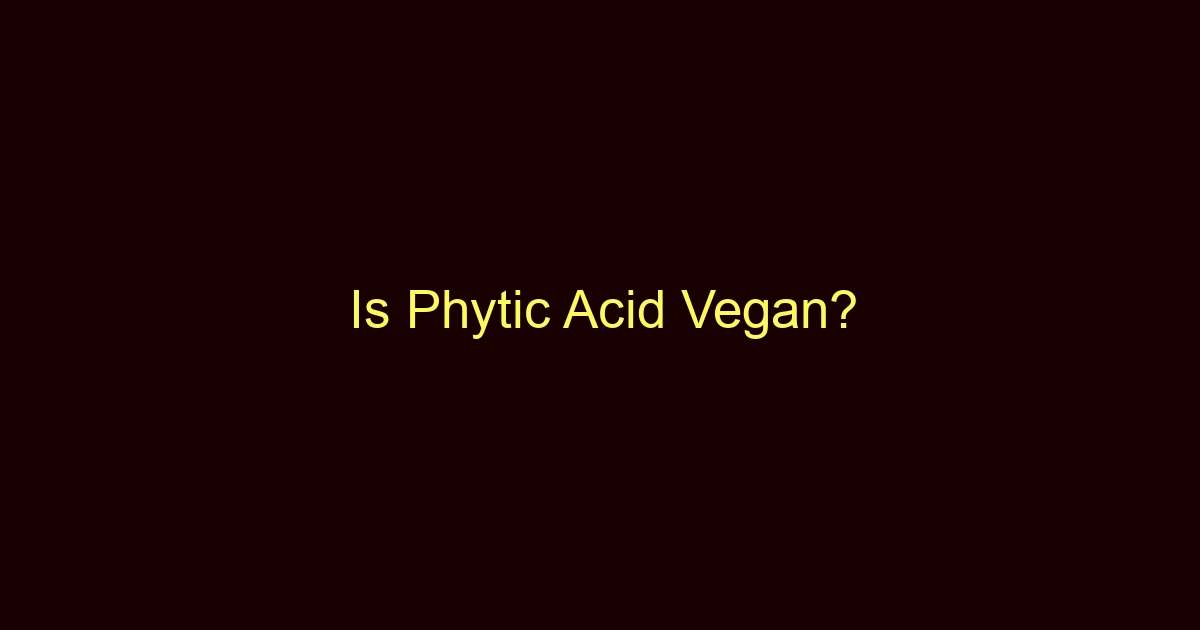Phytic Acid: a common nutrient yet surrounded by multiple debates. In the quest to adopt a diet aligning with their ethics, vegans often encounter several dilemmas, and Phytic Acid is one such. Let’s delve into understanding this intriguing component and its relationship with the vegan diet.
What is Phytic Acid?
Often heard within the discussions of nutrition, Phytic Acid or Inositol Hexaphosphate is a naturally occurring substance found primarily in nuts, seeds, legumes, and whole grains. Known for its ability to bind minerals, it’s a unique storage form of phosphorus that plants use. This compound can be considered a mixed bag of health benefits and potential concerns.
As a paradox, while Phytic Acid can compromise the bioavailability of certain minerals, it also unfolds with its powerful antioxidant properties. Scientists are keen on exploring its preventive role in chronic diseases like cancer and heart diseases. Hence, Phytic Acid isn’t merely a ‘nutritional robber’ but a ‘health guardian’ too.
What is Phytic Acid Made Of?
Phytic Acid is essentially a molecule of inositol attached to six molecules of phosphorus. Inositol is a type of sugar alcohol, while phosphorus is a mineral essential for numerous body functions. When combined, these elements form a unique structure with six ‘arms’ for capturing other minerals such as zinc, iron, and calcium.
In its raw state, Phytic Acid readily binds with minerals, forming phytates. This binding process often raises eyebrows since it hampers mineral absorption in our digestive tract. However, soaking, sprouting, or fermenting foods high in Phytic Acid can reduce these phytates, enhancing mineral bioavailability.
What is Phytic Acid Used For?
Phytic Acid is renowned in the food industry for its ability to act as a food preservative due to its antioxidant properties. Its strong mineral binding capacity also makes it an essential ingredient in some dental products for its potential to prevent tooth decay.
What Foods Contain Phytic Acid?
Phytic Acid is predominantly found in plant-based foods, especially in the outer layers of seeds, nuts, legumes, and grains. Foods high in Phytic Acid include almonds, tofu, beans, brown rice, and whole wheat.
Is Phytic Acid Vegan?
Yes, Phytic Acid is vegan. It is derived from plant sources, making it a completely plant-based and vegan-friendly compound. However, the debate surrounding Phytic Acid is not about its vegan status, but rather its impact on the absorption of minerals in the body.
When consumed in high amounts, Phytic Acid can reduce the absorption of iron, zinc, and calcium by binding to these minerals. But this is rarely a concern for those who follow a balanced and varied diet. Furthermore, methods such as soaking, sprouting, or fermenting can significantly reduce the Phytic Acid content in foods.
Can Vegans Eat Foods High in Phytic Acid and Why?
Yes, vegans can and often do eat foods high in Phytic Acid. These foods, including nuts, seeds, legumes, and whole grains, are staples of the vegan diet due to their high protein content. Despite the potential drawbacks of Phytic Acid, these foods are rich sources of essential nutrients.
Moreover, as mentioned earlier, methods like soaking, sprouting, or fermenting can reduce Phytic Acid’s impact on mineral absorption. Also, considering the potential health benefits of Phytic Acid, such as its antioxidant properties, its inclusion in a balanced diet could be beneficial.
The Potential Health Benefits of Phytic Acid
Phytic Acid is not just about potential drawbacks. It is known for several health benefits too. It has been recognized for its antioxidant properties, and research suggests it may play a role in cancer prevention. Phytic Acid’s ability to bind minerals also has a potential benefit – it may help to prevent the formation of kidney stones.
Moreover, it could have a beneficial role in controlling blood glucose levels. Several studies have suggested that Phytic Acid can slow down the rate at which sugars are absorbed into the bloodstream, which could be advantageous for people with diabetes.
The Debate Over Phytic Acid
The debate over Phytic Acid tends to revolve around its potential to interfere with mineral absorption. Some argue that in societies where cereal grains form a significant part of the diet, Phytic Acid could contribute to mineral deficiencies.
However, others maintain that the potential risks associated with Phytic Acid are generally overstated. They argue that the traditional food preparation methods like soaking, sprouting, and fermentation have been used for thousands of years specifically to decrease Phytic Acid and increase the bioavailability of nutrients.
Strategies to Mitigate the Effects of Phytic Acid
For those concerned about Phytic Acid, there are several strategies to mitigate its effects. Consuming vitamin C-rich foods along with meals can enhance iron absorption, and soaking grains and legumes can reduce the Phytic Acid content.
Moreover, fermenting foods can also help to break down Phytic Acid. In general, maintaining a diverse diet rich in various nutrients can ensure you receive the minerals your body needs, despite the presence of Phytic Acid.
Is Phytic Acid Safe?
Phytic Acid is generally considered safe. While it can reduce mineral absorption when consumed in large amounts, this is unlikely to be a problem for individuals consuming a balanced diet. Additionally, the potential health benefits of Phytic Acid should not be overlooked, as it has been associated with cancer prevention and improved blood sugar control.
Final Thoughts
Phytic Acid, despite its potential drawbacks, isn’t necessarily a villain. With its presence in many nutrient-dense plant foods, it’s often consumed by vegans and non-vegans alike. Although it can interfere with mineral absorption, a varied diet and traditional food preparation methods can largely mitigate its effects. Besides, it unfolds potential health benefits that add another layer to the intricate nutrition tapestry. Therefore, rather than eliminating Phytic Acid, a balanced approach to consumption appears to be the key.

